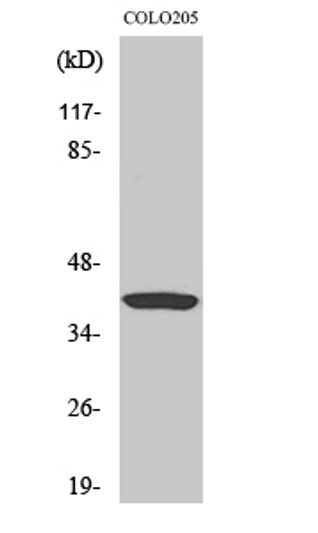| Function | Multifunctional protein that plays a central role in the cellular response to oxidative stress. The two major activities of APEX1 are DNA repair and redox regulation of transcriptional factors. Functions as an apurinic/apyrimidinic (AP) endodeoxyribonuclease in the base excision repair (BER) pathway of DNA lesions induced by oxidative and alkylating agents. Initiates repair of AP sites in DNA by catalyzing hydrolytic incision of the phosphodiester backbone immediately adjacent to the damage, generating a single-strand break with 5'-deoxyribose phosphate and 3'-hydroxyl ends. Also incises at AP sites in the DNA strand of DNA/RNA hybrids, single-stranded DNA regions of R-loop structures, and single-stranded RNA molecules. Operates at switch sites of immunoglobulin (Ig) constant regions where it mediates Ig isotype class switch recombination. Processes AP sites induced by successive action of AICDA and UNG. Generates staggered nicks in opposite DNA strands resulting in the formation of double-strand DNA breaks that are finally resolved via non-homologous end joining repair pathway. Has 3'-5' exodeoxyribonuclease activity on mismatched deoxyribonucleotides at the 3' termini of nicked or gapped DNA molecules during short-patch BER. Possesses DNA 3' phosphodiesterase activity capable of removing lesions (such as phosphoglycolate and 8-oxoguanine) blocking the 3' side of DNA strand breaks. Also acts as an endoribonuclease involved in the control of single-stranded RNA metabolism. Plays a role in regulating MYC mRNA turnover by preferentially cleaving in between UA and CA dinucleotides of the MYC coding region determinant (CRD). In association with NMD1, plays a role in the rRNA quality control process during cell cycle progression. Acts as a loading factor for POLB onto non-incised AP sites in DNA and stimulates the 5'-terminal deoxyribose 5'-phosphate (dRp) excision activity of POLB. Exerts reversible nuclear redox activity to regulate DNA binding affinity and transcriptional activity of transcriptional factors by controlling the redox status of their DNA-binding domain, such as the FOS/JUN AP-1 complex after exposure to IR. Involved in calcium-dependent down-regulation of parathyroid hormone (PTH) expression by binding to negative calcium response elements (nCaREs). Together with HNRNPL or the dimer XRCC5/XRCC6, associates with nCaRE, acting as an activator of transcriptional repression. May also play a role in the epigenetic regulation of gene expression by participating in DNA demethylation. Stimulates the YBX1-mediated MDR1 promoter activity, when acetylated at Lys-6 and Lys-7, leading to drug resistance. Plays a role in protection from granzyme-mediated cellular repair leading to cell death. Binds DNA and RNA. Associates, together with YBX1, on the MDR1 promoter. Together with NPM1, associates with rRNA. |
| Protein Name | Dna Repair Nuclease/Redox Regulator Apex1Apex NucleaseApenApurinic-Apyrimidinic Endonuclease 1Ap Endonuclease 1Ape-1Dna-(Apurinic Or Apyrimidinic Site EndonucleaseRedox Factor-1Ref-1 Cleaved Into - Dna Repair Nuclease/Redox Regulator Apex1 - Mitochondrial |
| Database Links | Reactome: R-HSA-110357Reactome: R-HSA-110362Reactome: R-HSA-110373Reactome: R-HSA-5651801Reactome: R-HSA-73930Reactome: R-HSA-73933 |
| Cellular Localisation | NucleusNucleolusNucleus SpeckleEndoplasmic ReticulumCytoplasmDetected In The Cytoplasm Of B-Cells Stimulated To SwitchColocalized With Sirt1 In The NucleusColocalized With Ybx1 In Nuclear Speckles After Genotoxic StressTogether With Ogg1 Is Recruited To Nuclear Speckles In Uva-Irradiated CellsColocalized With Nucleolin And Npm1 In The NucleolusIts Nucleolar Localization Is Cell Cycle Dependent And Requires Active Rrna TranscriptionColocalized With Calreticulin In The Endoplasmic ReticulumTranslocation From The Nucleus To The Cytoplasm Is Stimulated In Presence Of Nitric Oxide (No) And Function In A Crm1-Dependent MannerPossibly As A Consequence Of Demasking A Nuclear Export Signal (Amino Acid Position 64-80)S-Nitrosylation At Cys-93 And Cys-310 Regulates Its Nuclear-Cytosolic ShuttlingUbiquitinated Form Is Localized Predominantly In The CytoplasmDna Repair Nuclease/Redox Regulator Apex1Mitochondrial: MitochondrionThe Cleaved Apex2 Is Only Detected In MitochondriaTranslocation From The Cytoplasm To The Mitochondria Is Mediated By Ros Signaling And Cleavage Mediated By Granzyme ATom20-Dependent Translocated Mitochondrial Apex1 Level Is Significantly Increased After Genotoxic Stress |
| Alternative Antibody Names | Anti-Dna Repair Nuclease/Redox Regulator Apex1 antibodyAnti-Apex Nuclease antibodyAnti-Apen antibodyAnti-Apurinic-Apyrimidinic Endonuclease 1 antibodyAnti-Ap Endonuclease 1 antibodyAnti-Ape-1 antibodyAnti-Dna-(Apurinic Or Apyrimidinic Site Endonuclease antibodyAnti-Redox Factor-1 antibodyAnti-Ref-1 Cleaved Into - Dna Repair Nuclease/Redox Regulator Apex1 - Mitochondrial antibodyAnti-APEX1 antibodyAnti-APE antibodyAnti-APE1 antibodyAnti-APEX antibodyAnti-APX antibodyAnti-HAP1 antibodyAnti-REF1 antibody |
Information sourced from Uniprot.org











